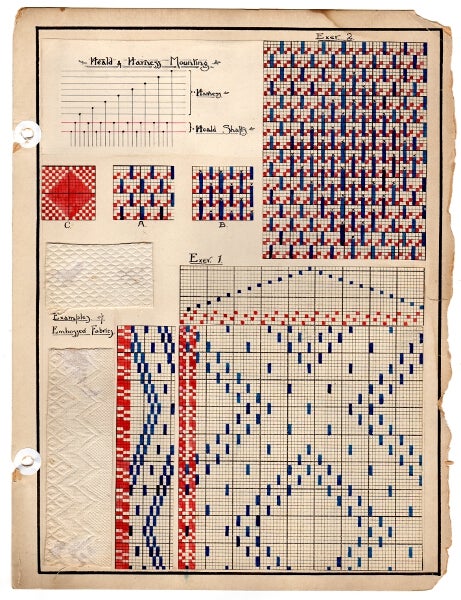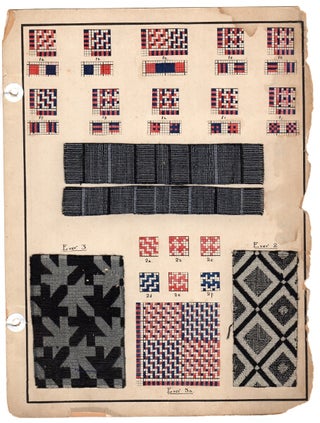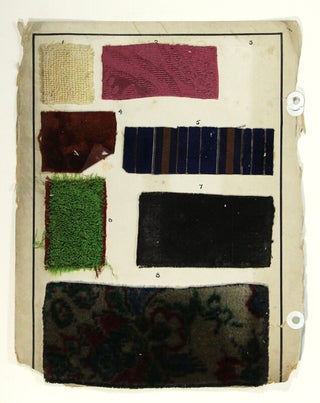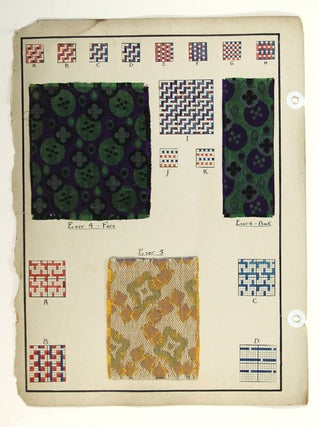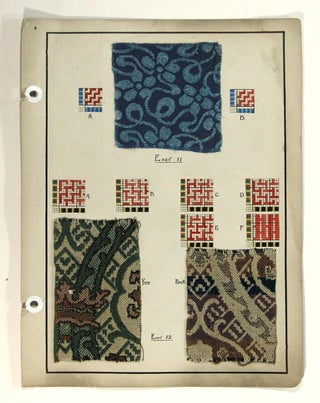Fibre technology
[Bradford, West Yorkshire: for City of Bradford, Technical College, Dept. of Textile Industries, 1918-1920]. Folio (approx. 13¼" x 9½"), pp. [74]; manuscript text in a cursive hand on ruled paper, including 18 leaves of hand-drawn color diagrams, several diagrams showing the set-up of a loom, 54 tipped-in fabric samples on card stock, contained in a two-ring binder with ownership signature and title on front pastedown, Bradford Technical College Stamps on rear pastedown, and with a professor's signature approving the manuscript; moderately worn, some chipping and soiling to the fore-edges, some soiling to end leaves. A cotton-, silk-, and wool-weaving manuscript made by a student, with numerous tipped-in samples, hand-drawn and lettered colored diagrams throughout. A remarkable artifact showing the training a weaver received at the Bradford Technical College. These course books were judged on completeness and the aspiring weaver's skill in presenting the details about the instruction, as well as their abilities to illustrate and accurately portray the production of (in this case) rather stunning cotton, silk, and woolen fabrics. The manuscript details the instructions for preparing the loom, and weaving diagrams for producing embossed fabrics, silk neckwear and men's ties, gauze and lace weaving, silk laces, tapestry weaving, muslins, madras muslins, machine- and hand-woven carpets - all of them with tipped-in fabric samples showing the resulting product. The beautifully executed color diagrams and illustrations show an aspiring weaver's professional abilities. The lettering demonstrates a decidedly pre-War Arts & Crafts influence, and the hand-colored diagrams detail Brussels Structure, Wilton Carpet Structure, Axminster Structures, Warp Pile Structures, various styles of tufts, Upper and Lower Comber-Board, and more. The City of Bradford Technical College was founded in 1882 to train English weavers and workers on new machinery, and feed the fast growing textile industry at the end of the 19th century. Its predecessor, the Bradford's Mechanics Institute did not encourage the education of workers and resisted training them on applied weaving theory as evidenced by the Swiss, French, and German weavers surpassing their products, and the poor response to the Braford Textiles at the 1878 Paris Exhibition. Just before World War I the Bradford Technical College had substantially expanded and opened state-of-the-art facilities for teaching weaving, spinning, dyeing, and finishing fabrics, which served them well during the post-War recovery. Manuscripts of this sort are uncommon due to their fragility and heavy use. Item #47836
Price: $1,500.00

